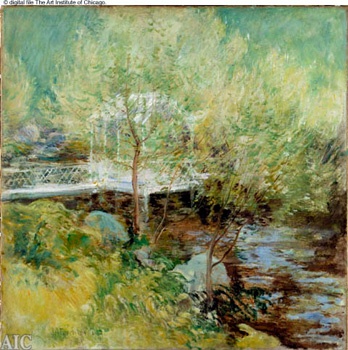Twachtman, John Henry
American painter
born August 4, 1853, Cincinnati, Ohio, U.S.
died August 8, 1902, Gloucester, Massachusetts
painter and etcher, one of the first American Impressionists (Impressionism).
Twachtman went to Munich, Germany, in 1875 to study painting and adopted the broad brushwork and warm, dark colouring of the Munich school. In 1883 he moved to Paris, where he studied at the Académie Julian. During this period he came into contact with Impressionism and began to paint with broken dabs of colour. Like many artists at the time, Twachtman was exposed to Japanism, the contemporary art world's interest in Japanese aesthetics.
 At first unsuccessful as a professional painter, he supported himself after 1889 by teaching at the Art Students League in New York City. During that year he mastered his lyrical interpretation of landscape. He usually painted scenes of nature veiled in cool, shimmering light—e.g., The White Bridge (1895). Among his best-known works are landscapes depicting winter or early spring scenes with delicate, high-keyed colour and strong, underlying formal construction—e.g., Hemlock Pool (c. 1902). Like the work of other American Impressionists, including William Merritt Chase (Chase, William Merritt) and Childe Hassam (Hassam, Childe), Twachtman's mature art had a strong regionalist appeal. He composed many of his strongest paintings in the landscape surrounding his home in Greenwich, Connecticut. Twachtman was a prominent member of a small group of American painters known as The Ten (Ten, The).
At first unsuccessful as a professional painter, he supported himself after 1889 by teaching at the Art Students League in New York City. During that year he mastered his lyrical interpretation of landscape. He usually painted scenes of nature veiled in cool, shimmering light—e.g., The White Bridge (1895). Among his best-known works are landscapes depicting winter or early spring scenes with delicate, high-keyed colour and strong, underlying formal construction—e.g., Hemlock Pool (c. 1902). Like the work of other American Impressionists, including William Merritt Chase (Chase, William Merritt) and Childe Hassam (Hassam, Childe), Twachtman's mature art had a strong regionalist appeal. He composed many of his strongest paintings in the landscape surrounding his home in Greenwich, Connecticut. Twachtman was a prominent member of a small group of American painters known as The Ten (Ten, The).Additional Reading
Deborah Chotner, Lisa N. Peters, and Kathleen A Pyne, John Twachtman: Connecticut Landscapes (1989); Lisa N. Peters, John Henry Twachtman: An American Impressionist (1999).
- Ursuline
- Urticaceae
- Uruapan
- Urubamba River
- Uruguaiana
- Uruguay
- Uruguay, flag of
- Uruguay River
- Urābī Pashaʿ
- Usa
- US Airways
- U.S.A. National Baptist Convention, Inc.
- U Saw
- USB
- USBC bowling championships-open division
- USBC bowling championshipswomen
- U.S. Corporate Bond Yields, Table
- U.S. Corporate Bond Yields, Table 1
- use
- USENET
- Userkaf
- Uses of spices and herbs with foods
- use tax
- U.S. Factory life and rules at Lowell, Massachusetts
- U.S. Government Long-Term Bond Yields, Table